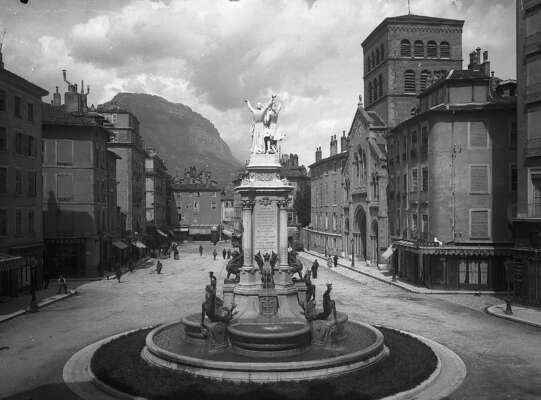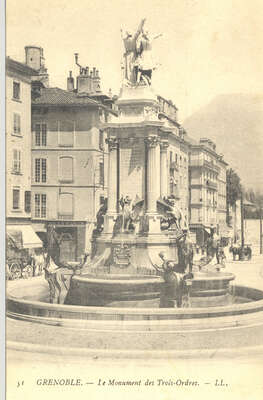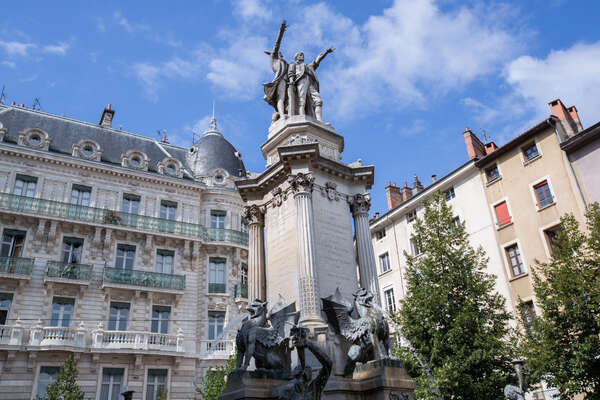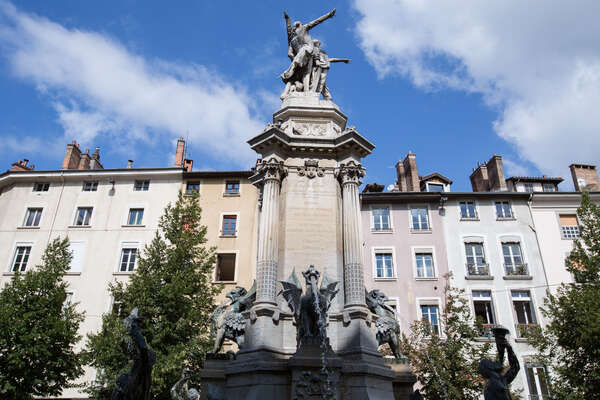
Fontaine des trois ordres, 1897, de Henri DING
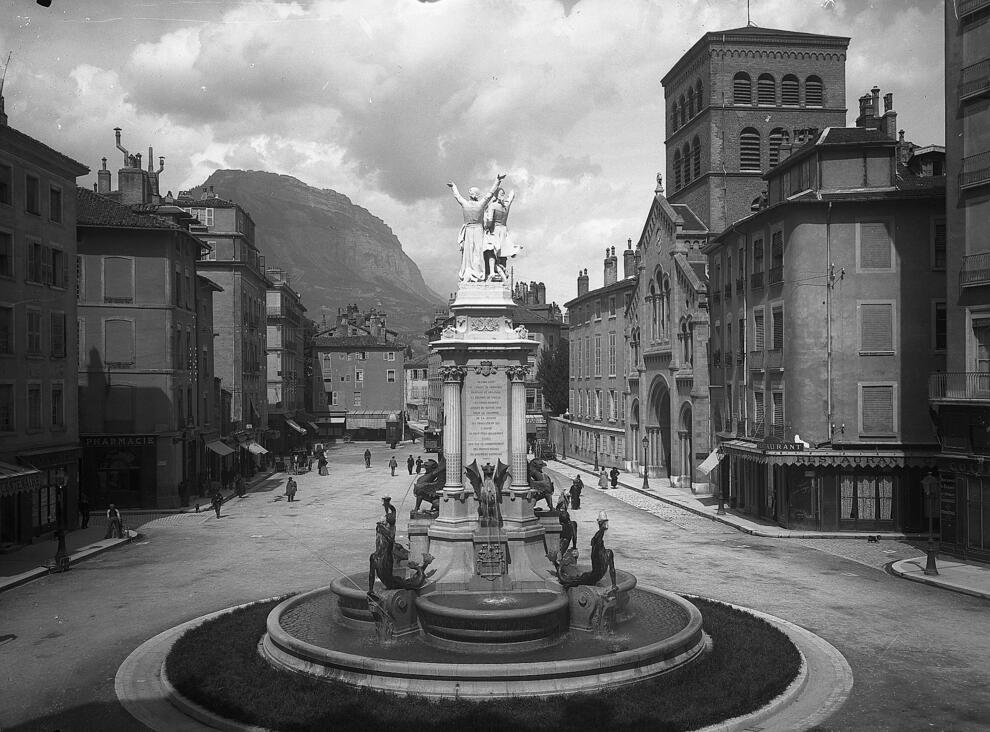
Fountain of the Three Orders, 1897. Fountain sculpture made from Echaillon stone and Carrera marble.
The Fountain of the Three Orders was erected in homage to the pre-revolutionary events of summer 1788 in Grenoble. In 1887, Henri DING (1844 - 1898), a teacher at the School of Fine Arts in Grenoble was put in charge of its creation and the inauguration took place some ten years later. There was originally an ornamental pond with swans at Place Notre-Dame, with a Corinthian column in the middle that can be seen today at Place de Metz. In this newly-available space, DING created a fountain with a 9-metre high square pedestal crowned with a group of three figures swearing an oath: nobility, the Third Estate and the clergy. Nobility is the only figure taking the oath with the correct hand, the right hand, whilst the clergy and the Third Estate are holding out their left hands. DING justified this by saying that he wanted to favour the overall view of the sculpture. In the middle of the fountain there are four tritons and four griffons made in bronze with alternating water jets. Only two griffons managed to escape being melted down in 1942. After the war, the piece was reconstructed with the help of the remaining griffons and photos of the tritons. Originally, the latter held their seashells in alternating hands, one in the left then one in the right, whereas today they are all holding them in their left hand. On the four sides of the base there are inscriptions relating to historical facts and recalling important dates from the French Revolution.
This work was commissioned by the town of Grenoble in 1887. The town of Grenoble has more than 150 works installed in public places that we invite you to discover thanks to several trails across the town and on the grenoble-patrimoine.fr website. These trails have been created with the help of the Département of Isère and the Auvergne-Rhône Alpes Regional Cultural Affairs Directorate.
La Fontaine des Trois ordres est élevée en hommage aux évènements pré-révolutionnaires de l'été 1788 à Grenoble. Henri DING (1844 - 1898), professeur à l'école des beaux-arts de Grenoble, est chargé en 1887 de sa réalisation et son inauguration a lieu dix ans plus tard. Avant l'érection de cette fontaine, la place Notre-Dame était occupée par une colonne corinthienne, visible aujourd'hui place de Metz, placée au centre d'un bassin décoré de cygnes.
DING conçoit sur l’espace libéré une fontaine supportant un piédestal carré de 9 mètres de haut en pierre de l'Echaillon couronné d'un groupe de trois personnages, en marbre de Carrare, prêtant serment : la noblesse, le tiers-état et le clergé. La noblesse prête serment de la bonne main, la droite, tandis que le clergé et le tiers-état tendent la main gauche. DING s'en justifiera, prétendant avoir voulu privilégier une vue d'ensemble. Des quatre griffons et quatre tritons adossés au piédestal et assurant la mise en scène de l'eau, seuls deux griffons réchappent des campagnes de fonte du bronze ordonnées pendant la Seconde Guerre mondiale (en 1942). Au lendemain du conflit, l'ensemble est reconstitué à partir des deux originaux restants et de photographies. Les conques, initialement tenues alternativement de la main gauche et de la main droite, sont désormais placées dans leur main droite. Les quatre faces du piédestal portent des inscriptions faisant références aux évènements de la Révolution française.
Cette œuvre est une commande de la Ville de Grenoble en 1887 et s'inscrit dans un ensemble de plus de 150 œuvres implantées sur l’espace public, que nous vous invitons à découvrir à travers plusieurs parcours dans la ville et sur le site grenoble-patrimoine.fr. Ces parcours ont été réalisés avec l’aide du Département de l’Isère et de la Direction Régionale des Affaires Culturelles Auvergne-Rhône Alpes.
Place Notre-Dame, Grenoble
Parcours associé
Période historique
5ème période : 1880 / 1925Classé en
- Patrimoine Monumental (Artistique, culturel et scientifique)
- Patrimoine Urbain (Mobilier Urbain)
Thématique(s)
- Art et culture
- Histoire & Evolution de la ville
En liaison avec cet élément du patrimoine
- Le Torrent
- Place Notre-Dame
- Musée de l’Ancien Evêché
- Groupe épiscopal : cathédrale Notre-Dame et église Saint-Hugues
- Mur–Fontaine, Ervin PATKAÏ
- Fontaine château d’eau Lavalette
- Fontaine du Lion et du Serpent, 1843, de Victor SAPPEY
- Collecte de regards photographiques 2019 : l'eau dans la ville
- Envoi à la refonte des sculptures de bronze









